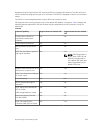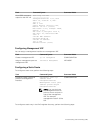
Figure 123. VRF Network Example
VRF Configuration Notes
Although there is no restriction on the number of VLANs that can be assigned to a VRF instance, the total
number of routes supported in VRF is limited by the size of the IPv4 CAM.
VRF is implemented in a network device by using Forwarding Information Bases (FIBs).
A network device may have the ability to configure different virtual routers, where entries in the FIB that
belong to one VRF cannot be accessed by another VRF on the same device. Only Layer 3 interfaces can
belong to a VRF. VRF is supported on following types of interface:
• Physical Ethernet interfaces
• Port-channel interfaces (static & dynamic using LACP)
• VLAN interfaces
• Loopback interfaces
VRF supports route redistribution between routing protocols (including static routes) only when the
routes are within the same VRF.
922
Virtual Routing and Forwarding (VRF)


















